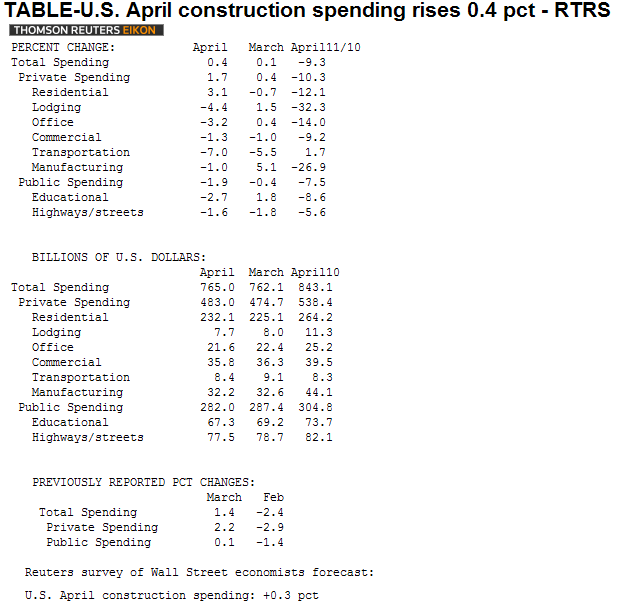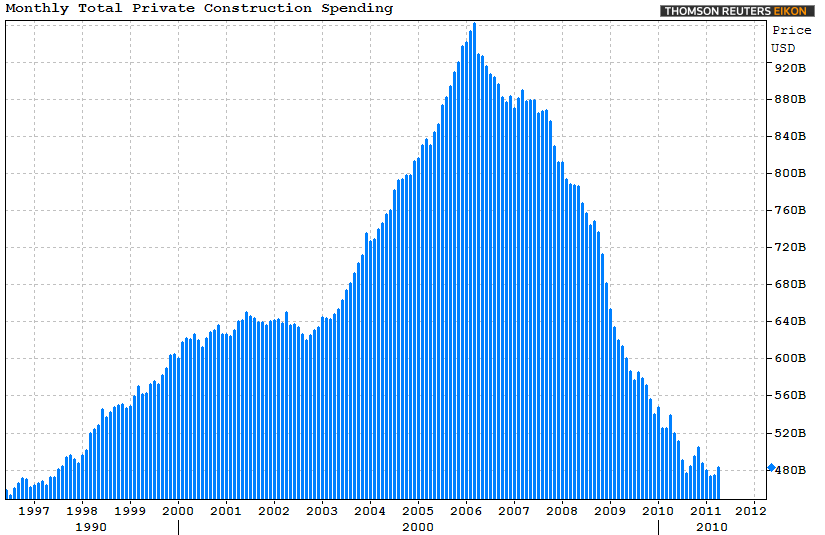The Census Bureau and Commerce Department have released Construction Spending data for April 2011.
Residential construction spending includes remodeling, additions, and major replacements to owner occupied properties subsequent to completion of original building. It includes construction of additional housing units in existing residential structures, finishing of basements and attics, modernization of kitchens, bathrooms, etc. Also included are improvements outside of residential structures, such as the addition of swimming pools and garages, and replacement of major equipment items such as water heaters, furnaces and central air-conditioners. Maintenance and repair work is not included. Projects are classified as privately owned or government owned (state, local, or federal government). The distinction is made on the basis of ownership during the construction period. READ MORE ABOUT DATA COLLECTION
Reuters Quick Recap...
RTRS - US APRIL CONSTRUCTION SPENDING +0.4 PCT (CONSENSUS +0.3) TO $765.0 BLN VS MARCH +0.1 PCT (PREV +1.4 PCT)
RTRS - US APRIL PRIVATE CONSTRUCTION SPENDING +1.7 PCT, PUBLIC SPENDING -1.9 PCT
RTRS - US APRIL TOTAL CONSTRUCTION SPENDING LARGEST RISE SINCE +1.1 PCT IN OCTOBER 2010

Excerpts from the Release....
The U.S. Census Bureau of the Department of Commerce announced today that construction spending during April 2011 was estimated at a seasonally adjusted annual rate of $765.0 billion, 0.4 percent (±1.6%)* above the revised March estimate of $762.1 billion. The April figure is 9.3 percent (±1.6%) below the April 2010 estimate of $843.1 billion. During the first 4 months of this year, construction spending amounted to $222.7 billion, 8.4 percent (±1.4%) below the $243.0 billion for the same period in 2010.

Residential construction was at a seasonally adjusted annual rate of $232.1 billion in April, 3.1 percent (±1.3%) above the revised March estimate of $225.1 billion. Nonresidential construction was at a seasonally adjusted annual rate of $250.8 billion in April, 0.5 percent (±1.4%)* above the revised March estimate of $249.6 billion.

Plain and Simple: Besides private residential spending, all aspects of this report indicated a decline in construction outlays in the month of April. Check out the table above to see it with your own eyes. With Housing Starts down 10.6% in April, the only logical explanation for this jump in residential construction spending is an uptick in rehab and renovation projects. HOW DO WE COME TO THAT CONCLUSION? Housing Starts data estimates how much new residential real estate construction occurred in the previous month. New Housing Starts construction means digging has begun. Adding rooms or renovating old ones does not count in Housing Starts data, the builder must be constructing a new home. Housing Starts were down but private residential construction spending was up? Had to be rehabs and renovations....
From: HUD Focused on Rebuilding America's Dilapidated Housing Inventory
"Take note of HUD-sponsored initiatives aimed at rebuilding America's dilapidated housing stock." says MND's Managing Editor Adam Quinones. "This is where housing professionals will find the most opportunity in years ahead. The FHA should reopen the 203(k) program to investors if they want to encourage private investment in the U.S. housing market."
From: Home Remodeling a Forward Indicator of Housing Bottom?
"With so many foreclosed properties sitting empty on the market we can expect remodeling and rehabbing to be a leading indicator of a bottom in the housing market", says MND's Managing Editor Adam Quinones. "We already know there is dearth of affordable rental housing available to low income renters. From that perspective, FHA should open its 203(k) program to investors if they want to accomplish their affordable housing goals."







